weight Lancia Ypsilon 2002 Owner handbook (in English)
[x] Cancel search | Manufacturer: LANCIA, Model Year: 2002, Model line: Ypsilon, Model: Lancia Ypsilon 2002Pages: 191, PDF Size: 2.45 MB
Page 29 of 191
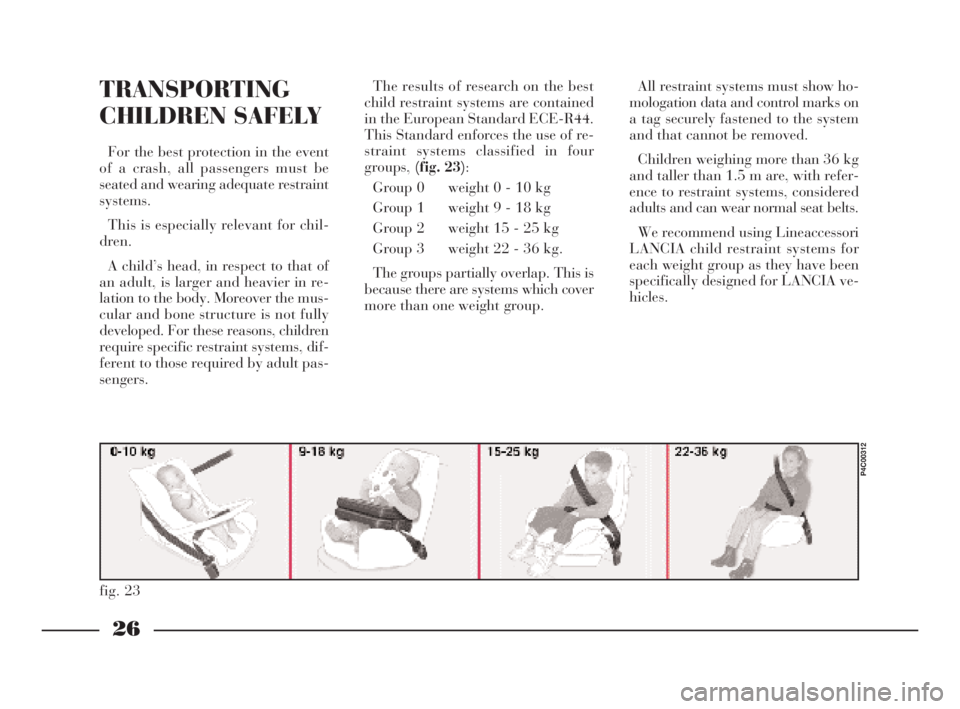
26
G
fig. 23
P4C00312
TRANSPORTING
CHILDREN SAFELY
For the best protection in the event
of a crash, all passengers must be
seated and wearing adequate restraint
systems.
This is especially relevant for chil-
dren.
A child’s head, in respect to that of
an adult, is larger and heavier in re-
lation to the body. Moreover the mus-
cular and bone structure is not fully
developed. For these reasons, children
require specific restraint systems, dif-
ferent to those required by adult pas-
sengers.The results of research on the best
child restraint systems are contained
in the European Standard ECE-R44.
This Standard enforces the use of re-
straint systems classified in four
groups,(fig. 23):
Group 0 weight 0 - 10 kg
Group 1 weight 9 - 18 kg
Group 2 weight 15 - 25 kg
Group 3 weight 22 - 36 kg.
The groups partially overlap. This is
because there are systems which cover
more than one weight group.All restraint systems must show ho-
mologation data and control marks on
a tag securely fastened to the system
and that cannot be removed.
Children weighing more than 36 kg
and taller than 1.5 m are, with refer-
ence to restraint systems, considered
adults and can wear normal seat belts.
We recommend using Lineaccessori
LANCIA child restraint systems for
each weight group as they have been
specifically designed for LANCIA ve-
hicles.
4C001-067 ING 11-03-2008 11:57 Pagina 26
Page 30 of 191
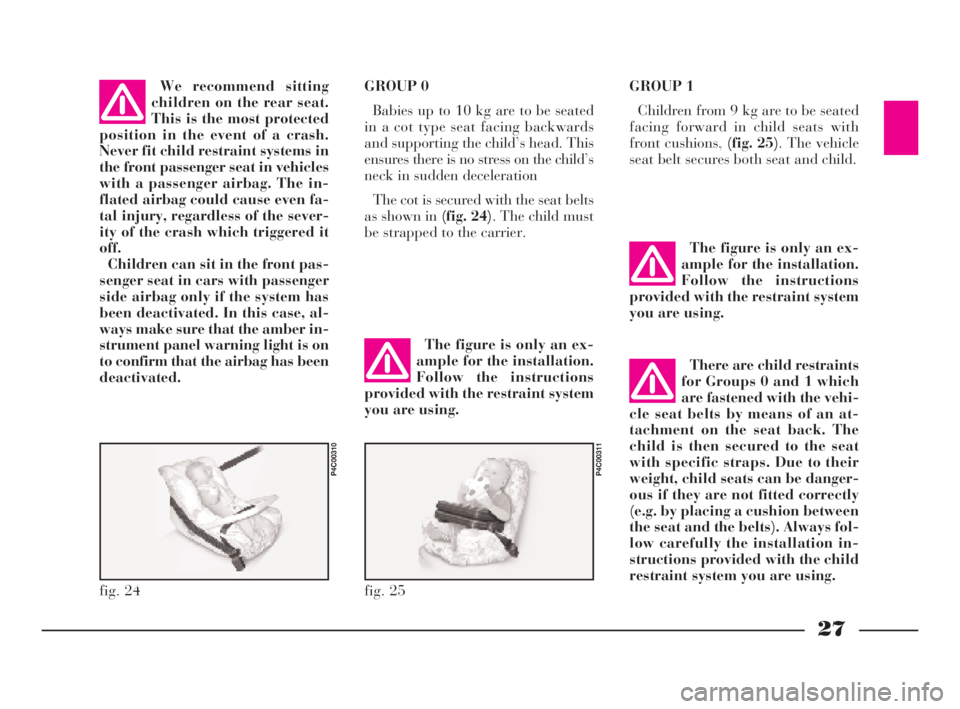
27
G
fig. 24
P4C00310
fig. 25
P4C00311
We recommend sitting
children on the rear seat.
This is the most protected
position in the event of a crash.
Never fit child restraint systems in
the front passenger seat in vehicles
with a passenger airbag. The in-
flated airbag could cause even fa-
tal injury, regardless of the sever-
ity of the crash which triggered it
off.
Children can sit in the front pas-
senger seat in cars with passenger
side airbag only if the system has
been deactivated. In this case, al-
ways make sure that the amber in-
strument panel warning light is on
to confirm that the airbag has been
deactivated.GROUP 0
Babies up to 10 kg are to be seated
in a cot type seat facing backwards
and supporting the child’s head. This
ensures there is no stress on the child’s
neck in sudden deceleration
The cot is secured with the seat belts
as shown in (fig. 24). The child must
be strapped to the carrier.GROUP 1
Children from 9 kg are to be seated
facing forward in child seats with
front cushions, (fig. 25). The vehicle
seat belt secures both seat and child.
The figure is only an ex-
ample for the installation.
Follow the instructions
provided with the restraint system
you are using.
The figure is only an ex-
ample for the installation.
Follow the instructions
provided with the restraint system
you are using.
There are child restraints
for Groups 0 and 1 which
are fastened with the vehi-
cle seat belts by means of an at-
tachment on the seat back. The
child is then secured to the seat
with specific straps. Due to their
weight, child seats can be danger-
ous if they are not fitted correctly
(e.g. by placing a cushion between
the seat and the belts). Always fol-
low carefully the installation in-
structions provided with the child
restraint system you are using.
4C001-067 ING 11-03-2008 11:57 Pagina 27
Page 54 of 191

51
G
BOOT
OPENING/CLOSING
THE TAILGATE
To open the boot from the outside,
unlock it with the ignition key A
(fig. 72).
To open it from inside the car, pull
leverA (fig. 73)at the side of the dri-
ver’s seat.
To lift the tailgate, use the grip lo-
cated between the two number plate
lights.When the tailgate is closed, it will
lock automatically, and can only be
reopened by using the key or pulling
leverA (fig. 73)inside the car.
IMPORTANTNever leave the keys
in the boot.
Use the handle situated in the inte-
rior trim of the tailgate A (fig. 74)to
lower it without getting your hands
dirty.
To close the tailgate, lower it and
press in the centre until you hear it
lock.
fig. 72
P4C00021
fig. 73
P4C00015
Do not work boot release
lever when the car is in
motion.
The addition of objects to
the rear parcel shelf or
tailgate (loudspeakers,
spoiler, etc.) may prevent the gas-
filled struts at the sides of the tail-
gate working properly. Items
arranged on the rear window shelf
could be thrown forwards and in-
jure passengers should you brake
sharply.
fig. 74
P4C00037
When using the boot,
make sure the load you are
carrying does not exceed
the permitted weight (see the
“Technical specifications” sec-
tion). Also ensure the items in the
boot are arranged properly to pre-
vent them being thrown forward
and injurying passengers should
you brake sharply.
4C001-067 ING 11-03-2008 11:57 Pagina 51
Page 58 of 191
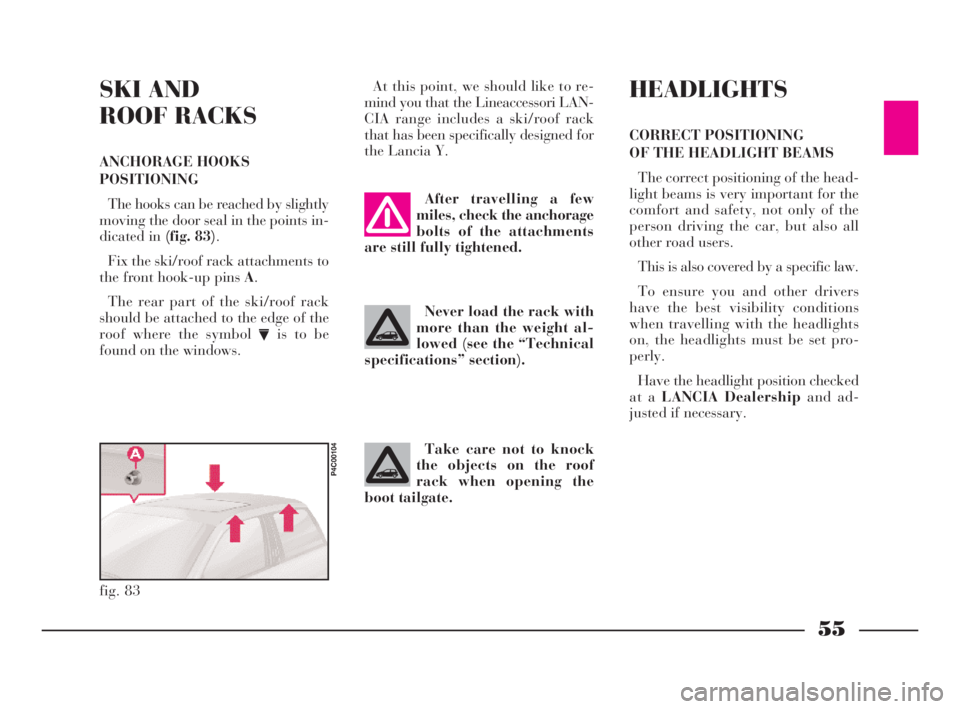
55
G
SKI AND
ROOF RACKS
ANCHORAGE HOOKS
POSITIONING
The hooks can be reached by slightly
moving the door seal in the points in-
dicated in (fig. 83).
Fix the ski/roof rack attachments to
the front hook-up pins A.
The rear part of the ski/roof rack
should be attached to the edge of the
roof where the symbol
Vis to be
found on the windows.At this point, we should like to re-
mind you that the Lineaccessori LAN-
CIA range includes a ski/roof rack
that has been specifically designed for
the Lancia Y.
fig. 83
P4C00104
After travelling a few
miles, check the anchorage
bolts of the attachments
are still fully tightened.
Never load the rack with
more than the weight al-
lowed (see the “Technical
specifications” section).
Take care not to knock
the objects on the roof
rack when opening the
boot tailgate.
HEADLIGHTS
CORRECT POSITIONING
OF THE HEADLIGHT BEAMS
The correct positioning of the head-
light beams is very important for the
comfort and safety, not only of the
person driving the car, but also all
other road users.
This is also covered by a specific law.
To ensure you and other drivers
have the best visibility conditions
when travelling with the headlights
on, the headlights must be set pro-
perly.
Have the headlight position checked
at a LANCIA Dealershipand ad-
justed if necessary.
4C001-067 ING 11-03-2008 11:57 Pagina 55
Page 65 of 191
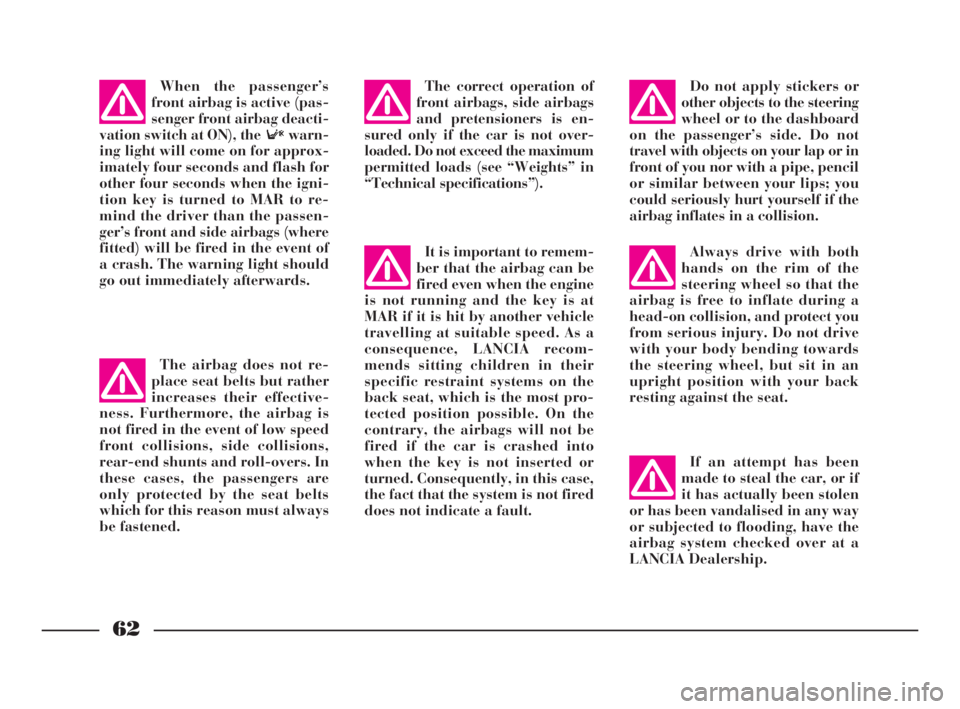
62
G
It is important to remem-
ber that the airbag can be
fired even when the engine
is not running and the key is at
MAR if it is hit by another vehicle
travelling at suitable speed. As a
consequence, LANCIA recom-
mends sitting children in their
specific restraint systems on the
back seat, which is the most pro-
tected position possible. On the
contrary, the airbags will not be
fired if the car is crashed into
when the key is not inserted or
turned. Consequently, in this case,
the fact that the system is not fired
does not indicate a fault.Always drive with both
hands on the rim of the
steering wheel so that the
airbag is free to inflate during a
head-on collision, and protect you
from serious injury. Do not drive
with your body bending towards
the steering wheel, but sit in an
upright position with your back
resting against the seat.
If an attempt has been
made to steal the car, or if
it has actually been stolen
or has been vandalised in any way
or subjected to flooding, have the
airbag system checked over at a
LANCIA Dealership. Do not apply stickers or
other objects to the steering
wheel or to the dashboard
on the passenger’s side. Do not
travel with objects on your lap or in
front of you nor with a pipe, pencil
or similar between your lips; you
could seriously hurt yourself if the
airbag inflates in a collision.
The correct operation of
front airbags, side airbags
and pretensioners is en-
sured only if the car is not over-
loaded. Do not exceed the maximum
permitted loads (see “Weights” in
“Technical specifications”).When the passenger’s
front airbag is active (pas-
senger front airbag deacti-
vation switch at ON), the warn-
ing light will come on for approx-
imately four seconds and flash for
other four seconds when the igni-
tion key is turned to MAR to re-
mind the driver than the passen-
ger’s front and side airbags (where
fitted) will be fired in the event of
a crash. The warning light should
go out immediately afterwards.
The airbag does not re-
place seat belts but rather
increases their effective-
ness. Furthermore, the airbag is
not fired in the event of low speed
front collisions, side collisions,
rear-end shunts and roll-overs. In
these cases, the passengers are
only protected by the seat belts
which for this reason must always
be fastened.
4C001-067 ING 11-03-2008 11:57 Pagina 62
Page 78 of 191
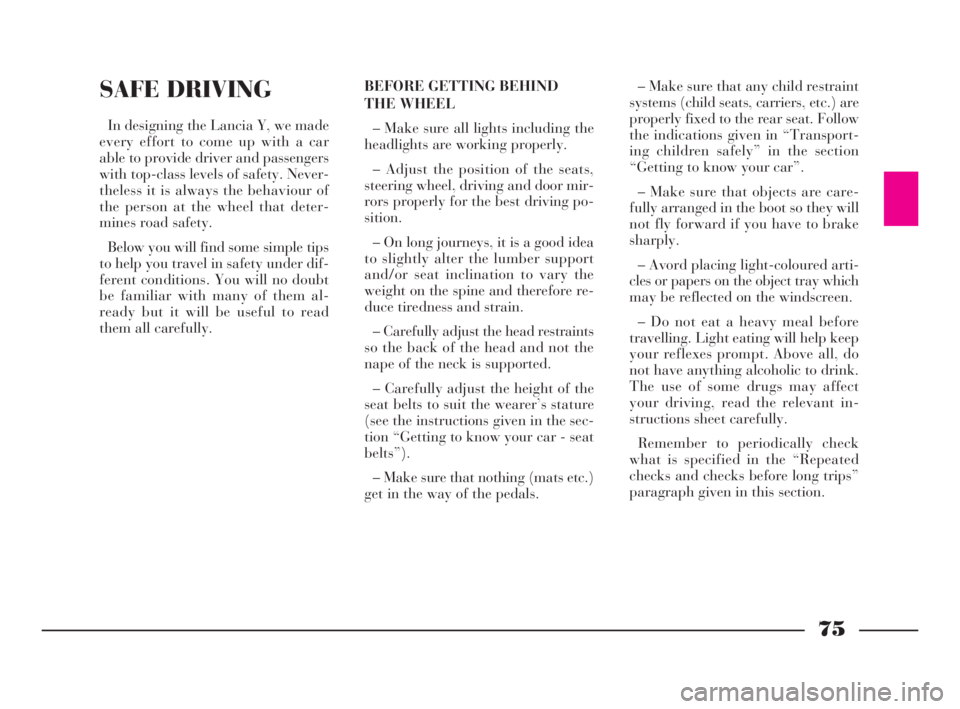
75
G
SAFE DRIVING
In designing the Lancia Y, we made
every effort to come up with a car
able to provide driver and passengers
with top-class levels of safety. Never-
theless it is always the behaviour of
the person at the wheel that deter-
mines road safety.
Below you will find some simple tips
to help you travel in safety under dif-
ferent conditions. You will no doubt
be familiar with many of them al-
ready but it will be useful to read
them all carefully.BEFORE GETTING BEHIND
THE WHEEL
– Make sure all lights including the
headlights are working properly.
– Adjust the position of the seats,
steering wheel, driving and door mir-
rors properly for the best driving po-
sition.
– On long journeys, it is a good idea
to slightly alter the lumber support
and/or seat inclination to vary the
weight on the spine and therefore re-
duce tiredness and strain.
– Carefully adjust the head restraints
so the back of the head and not the
nape of the neck is supported.
– Carefully adjust the height of the
seat belts to suit the wearer’s stature
(see the instructions given in the sec-
tion “Getting to know your car - seat
belts”).
– Make sure that nothing (mats etc.)
get in the way of the pedals.– Make sure that any child restraint
systems (child seats, carriers, etc.) are
properly fixed to the rear seat. Follow
the indications given in “Transport-
ing children safely” in the section
“Getting to know your car”.
– Make sure that objects are care-
fully arranged in the boot so they will
not fly forward if you have to brake
sharply.
– Avord placing light-coloured arti-
cles or papers on the object tray which
may be reflected on the windscreen.
– Do not eat a heavy meal before
travelling. Light eating will help keep
your reflexes prompt. Above all, do
not have anything alcoholic to drink.
The use of some drugs may affect
your driving, read the relevant in-
structions sheet carefully.
Remember to periodically check
what is specified in the “Repeated
checks and checks before long trips”
paragraph given in this section.
4C068-089 ING 11-03-2008 11:59 Pagina 75
Page 84 of 191
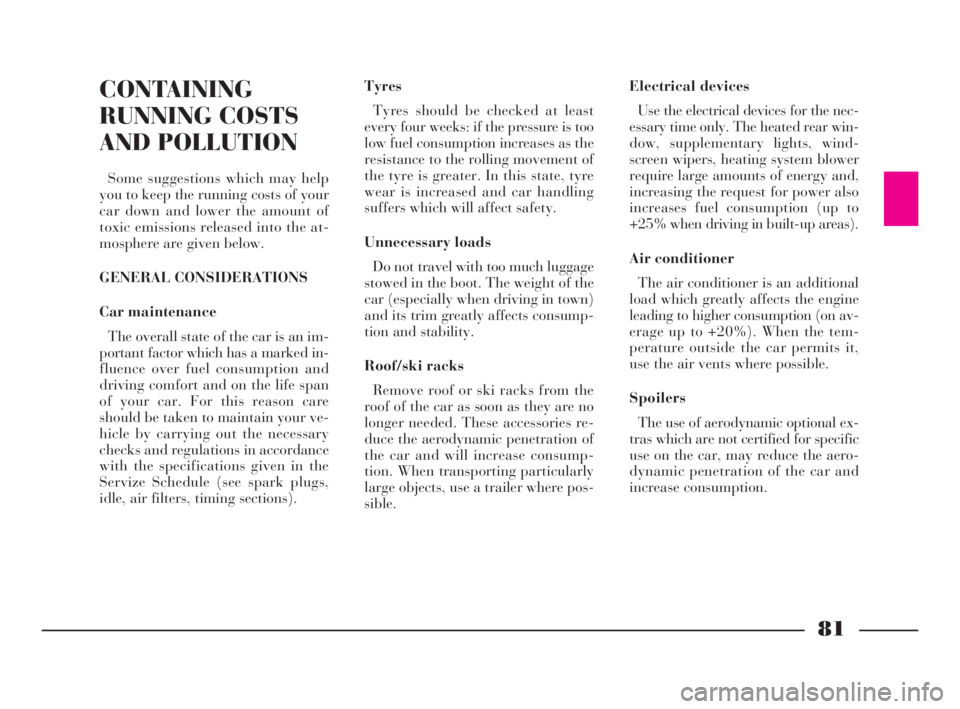
81
G
CONTAINING
RUNNING COSTS
AND POLLUTION
Some suggestions which may help
you to keep the running costs of your
car down and lower the amount of
toxic emissions released into the at-
mosphere are given below.
GENERAL CONSIDERATIONS
Car maintenance
The overall state of the car is an im-
portant factor which has a marked in-
fluence over fuel consumption and
driving comfort and on the life span
of your car. For this reason care
should be taken to maintain your ve-
hicle by carrying out the necessary
checks and regulations in accordance
with the specifications given in the
Servize Schedule (see spark plugs,
idle, air filters, timing sections).Tyres
Tyres should be checked at least
every four weeks: if the pressure is too
low fuel consumption increases as the
resistance to the rolling movement of
the tyre is greater. In this state, tyre
wear is increased and car handling
suffers which will affect safety.
Unnecessary loads
Do not travel with too much luggage
stowed in the boot. The weight of the
car (especially when driving in town)
and its trim greatly affects consump-
tion and stability.
Roof/ski racks
Remove roof or ski racks from the
roof of the car as soon as they are no
longer needed. These accessories re-
duce the aerodynamic penetration of
the car and will increase consump-
tion. When transporting particularly
large objects, use a trailer where pos-
sible.Electrical devices
Use the electrical devices for the nec-
essary time only. The heated rear win-
dow, supplementary lights, wind-
screen wipers, heating system blower
require large amounts of energy and,
increasing the request for power also
increases fuel consumption (up to
+25% when driving in built-up areas).
Air conditioner
The air conditioner is an additional
load which greatly affects the engine
leading to higher consumption (on av-
erage up to +20%). When the tem-
perature outside the car permits it,
use the air vents where possible.
Spoilers
The use of aerodynamic optional ex-
tras which are not certified for specific
use on the car, may reduce the aero-
dynamic penetration of the car and
increase consumption.
4C068-089 ING 11-03-2008 11:59 Pagina 81
Page 88 of 191

85
G
The ABS system with
which the car may be fitted
does not control the brak-
ing system of a trailer. Special care
must therefore be taken on slip-
pery surfaces.
Under no circumstances
modify the car’s braking
system for trailer braking
control. The trailer’s braking sys-
tem must be completely indepen-
dent of the car’s hydraulic system.The weight the trailer exerts on the
car’s tow hitch coupling reduces the
car’s carrying capacity by the same
amount.
In order to be sure you are not ex-
ceeding the maximum towing weight
(given on the car’s registration pa-
pers), you have to take into account
the trailer’s weight fully laden in-
cluding the accessories and personal
luggage.
Do not exceed the speed limits for
towing a trailer in the country you are
driving in. In any case, do not exceed
the top speed of 100 km/h.SNOW CHAINS
The use of snow chains is regulated
by the legislation in force in the coun-
try the car is driven in.
The chains may only be applied to
the drive wheel tyres (front wheels).
Use only low profile chains (maxi-
mum height off the tyre: 12 mm).
Check the tautness of the chains af-
ter driving some twenty to thirty me-
tres.
IMPORTANTAs the spare wheel is
small (space-saver), it is not possible
to fit snow chains to it. If a front tyre
is punctured, first exchange a rear
wheel with the spare tyre and then
change the flat tyre with the rear wheel
thus removed. This way there will be
two ordinary wheels at the front and
the snow chains can be fitted.
Remember that the wheels should
always be exchanged on the same side
of the vehicle; never change wheels
over from one side of the car to the
other.
4C068-089 ING 11-03-2008 11:59 Pagina 85
Page 99 of 191

96
G
Never fit a standard tyre to a rim
to be used for the space-saver
spare wheel. Have the punctured
tyre repaired and fitted back on as
soon as possible.
No more than one space-saver
spare wheel must be used at the
same time.
Do not grease the bolt threads be-
fore fitting them, they could un-
screw themselves.
The jack must only be used to
change wheels on the vehicle with
which it is supplied or on vehicles
of the same model. All other uses,
for example raising other vehicles,
must be excluded. Under no cir-
cumstances use the jack to carry
out repairs under the vehicle.
If the jack is not used correctly,
the raised vehicle may fall.Do not use the jack to lift weights
above that indicated on the label
attached to the jack itself.
Never start the engine while the
car is raised by the jack. If travel-
ling with a trailer, detach the
trailer before raising the car.
Snow chains cannot be fitted to
the spare wheel, consequently if a
front tyre is punctured (front drive)
and snow chains need to be fitted,
a standard wheel must be removed
from the back axle and the space-
saver spare wheel fitted in its
place. In this way there will be two
standard wheels on the front and
the snow chains can be fitted.
Incorrect fitting of the wheel hub
could result in the hub coming off
when the vehicle is travelling.Never tamper with the inflation
valve.
Do not insert any type of tool be-
tween the rim and the tyre.
Periodically check the tyre pres-
sure including that of the spare-
saver spare wheel as per the val-
ues given in “Technical Specifica-
tions”.
fig. 3
P4C00401
fig. 2
P4C00400
4C090-119 ING 11-03-2008 12:00 Pagina 96
Page 117 of 191

114
fG
WITH A SHOP JACK
Front end
The car may only be raised by plac-
ing the jack arm under the transaxle,
with a block of wood or rubber as il-
lustrated in (fig. 38).IF THE CAR NEEDS
TO BE RAISED
WITH THE JACK
See “If a tyre is punctured”, in this
section.
The jack should only be
used to change a wheel on
the vehicle with which it is
supplied or on vehicles of the same
model. All other uses, for example
raising other vehicles, must be ex-
cluded. Under no circumstances
use the jack to carry out repairs
under the vehicle.
If the jack is not used
correctly, the raised vehi-
cle may fall. Do not use the
jack to lift weights above that in-
dicated on the label attached to the
jack itself.
It must be remembered that:
– the jack does not require adjust-
ments;
– the jack cannot be repaired. If it
breaks, it must be changed with an-
other new jack;
– only the jack handle described in
the chapter “If a tyre is punctured”
can be fitted onto the jack.
fig. 38
P4C00393
4C090-119 ING 13-03-2008 12:51 Pagina 114